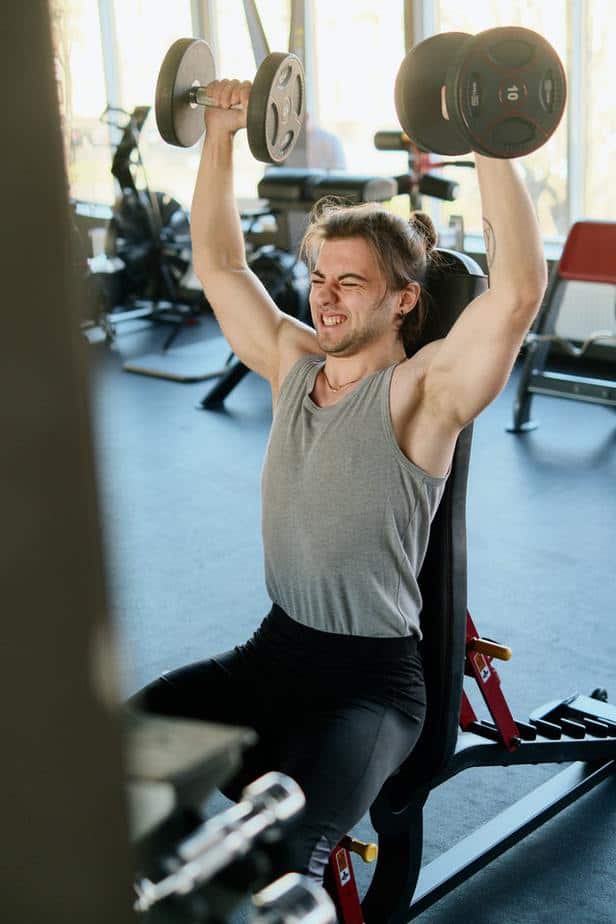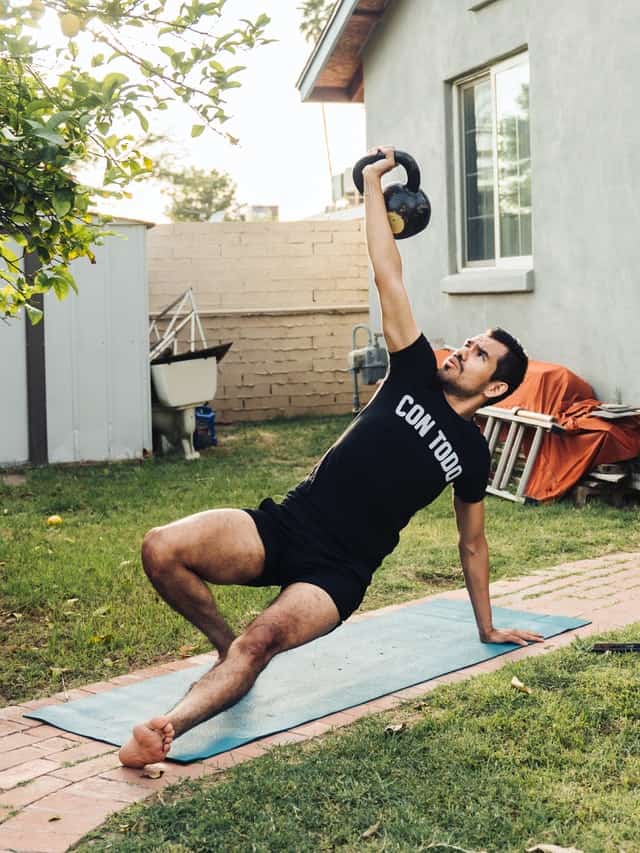
The overhead press is a foundational lift that benefits bodybuilders and powerlifters alike. However, it’s also one of the first lifts to level out and stop progressing. If you’ve hit a shoulder press plateau, you’re not alone.
Here are seven tips for improving overhead press exercises and hitting a new PR.
Contents
Why is Overhead Press so Hard?
Why do so many people struggle with the overhead press? Unlike many of the other big lifts in the gym, the primary movers in the overhead press are relatively small muscles. While this exercise engages your entire body, it doesn’t use force from the larger muscle groups, like your quads.
As the primary movers are smaller muscles, it’s harder to use brute force to get through the lift. Your compensations and deficiencies quickly become apparent, and subtle tweaks to form can make a significant impact.
Finally, your shoulders are a complex mechanism. Any underlying issues here can lead to a shoulder press plateau.
Why Isn’t My Shoulder Press Getting Stronger?
There could be a variety of factors limiting your overhead press progression. First, consider how long you’ve been actively lifting and training. When you first get into the gym, PRs and progression come quickly and easily. This phenomenon happens because your body is learning what you can do. Eventually, you reach your “newbie PR” limit and need to focus on building strength and muscle.
Another reason for hitting a shoulder press plateau is a subtle form discrepancy. Even something as simple as moving your hands an inch inward can impact your overhead power.
Finally, you could be experiencing a weak shoulder press because you’re not giving your muscles enough time to recover between workouts or sets. Consider expanding or modifying your routine to include other effective shoulder workouts to help improve recovery time and balance out your training.

How Much Weight Should You be able to Overhead Press?
Ideally, a beginner should be able to overhead press a quarter of their body weight. An advanced lifter should be able to hit their bodyweight and above.
However, while calculating strength standards are a great way to benchmark progress, they can be arbitrary. Numbers are often self-reported and don’t account for form and technique. For example, if you bend your knees to drive your overhead press, you’re doing a push press rather than a strict press. Reporting this as a strict press would be inaccurate and skew the numbers.
Additionally, there are biological factors to consider. Generally speaking, females have more muscular endurance, whereas males have more muscular strength. A female might have a better weight ratio when doing a 3RM workout, while men tend to have more power for a 1RM.
Age, underlying issues, and body type will all play a role in how much you should be able to overhead press.
How to Improve Your Overhead Press
When determining how to improve your overhead press, it’s best to take a step-by-step approach to the process. Troubleshoot your overhead press and fix one thing at a time for the best possible results.
Here are seven steps to increase your overhead press.
1. Learn to Brace Your Core
Your shoulders may be the primary movers during an overhead press, but your success is contingent on trunk stability. Learning how to brace your core properly and engage your stabilizers is essential for increasing your overhead press.
Start by assessing your stance. When pressing, your pelvis should be tucked and tilted forward. Many lifters overcompensate by leaning back slightly, which causes an anterior pelvic tilt— your cervical spine curves forward, your pelvis tilts forward, and your glutes curve back, limiting engagement. This stance loads the spine in a damaging way and reduces stability and strength.
Tuck your pelvis in and take a deep breath, bracing your core before lifting. Keep a neutral spine and pause to readjust if needed during your reps. Know that if you must pause, your body uses less energy resting at the top of an overhead press— many lifters rest at the bottom of the movement and lose their power.
In addition to bracing your core, you should also activate your legs and glutes to create a stronger base. When you let your spine and glutes bow to cheat the reps, you’re really cheating your progress.
2. Adjust Your Grip
Another common mistake that leads to a weak shoulder press is a wide grip.
The logic is sound: a wider grip will reduce the range of motion required to achieve full extension, right? While it works in theory, it doesn’t work in the overhead press.
When you shift to a wider grip, you’re disrupting the chain of movement. By keeping a narrow grip, you’re stacking the power in alignment with the rest of the body and creating force as you push upward in a straight line. This movement also helps prevent elbow flaring and accidental rotation in your shoulder, causing a plethora of injuries.
In addition to keeping your grip and elbows tucked close to the body, ensure that your wrists are stacked with knuckles facing the ceiling.
3. Alter Reps and Weight
Create variability in your training by focusing on volume rather than weight. By dropping the weights and increasing the reps, you can continue to increase the volume and overload the muscles to build strength.
For example, if you usually do four sets of six reps at 200lbs, your total overhead press volume would be 4800lbs. If you can’t add more weight to the 4×6 structure, you can drop the weight to 175lbs and push for eight reps for a volume total of 5350lbs at a lighter weight.
Creating a program with variability will help you push through a shoulder press plateau.
4. Do Stand-Alone Overhead Training
The small upper body muscles that act as primary movers during an overhead press get tired quickly. If you’re experiencing limited overhead press progression, you could be burnt out from inadequate rest and recovery.
If your overhead press is usually a part of a larger upper body workout, shift your schedule. You could be getting tired out from the bench press before you even start overhead pressing. Consider adding a stand-alone overhead training session or putting this exercise at the start of your workout.
5. Use Accessory Exercises

Accessory exercises play a big role in improving your overhead press. Some common overhead press assistance exercises include:
- pull-ups
- pull-up negatives
- push presses
- dips
- seated dumbbell shoulder press
- single-arm dumbbell press
- Turkish get-ups
By isolating the primary movers and targeting them in different ways, you can improve your overhead press.
6. Use Fractional Plates
Don’t let your ego get in the way of progress. Fractional plates are ideal for when your overhead press progression hits a standstill. They’re perfect for those days when a 5lb jump is too much, but you still have more in the tank.
Fractional plates come in 0.25lbs, 0.5lbs, 0.75lbs and 1lb measurements. As your strength levels out and reaches the limits, these small increments can make a big difference over time.
7. Prioritize Mobility and Shoulder Health
Prioritizing mobility and protecting your shoulders’ health is vital to start the day you begin lifting. Whether you’re lifting a 1RM or an empty barbell, you should always start with a proper warm-up that incorporates dynamic movements.
Practicing mobility means learning how to be strong throughout the entire movement. It’s overcoming your compensations through stretching, muscle activation, flexion, and rotation. Most importantly, mobility training prevents injuries that could derail your progress and make this temporary setback permanent.
Conclusion
When trying to figure out how to improve your overhead press, take a closer look at your form and training program. Work to reduce compensations and create a strong base to support the movement. Make small, strategic changes rather than letting your ego call the shots.
With time, you’ll break through your shoulder press plateau and see that increase in numbers that you desire.